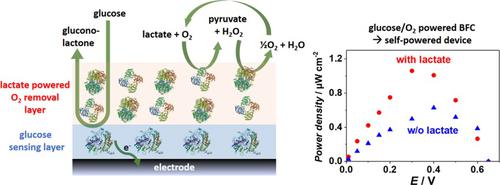当前位置:
X-MOL 学术
›
Electroanalysis
›
论文详情
Our official English website, www.x-mol.net, welcomes your feedback! (Note: you will need to create a separate account there.)
An O2 Tolerant Polymer/Glucose Oxidase Based Bioanode as Basis for a Self‐powered Glucose Sensor
Electroanalysis ( IF 3 ) Pub Date : 2018-01-12 , DOI: 10.1002/elan.201700785 Francesca Lopez 1 , Sarra Zerria 1 , Adrian Ruff 1 , Wolfgang Schuhmann 1
Electroanalysis ( IF 3 ) Pub Date : 2018-01-12 , DOI: 10.1002/elan.201700785 Francesca Lopez 1 , Sarra Zerria 1 , Adrian Ruff 1 , Wolfgang Schuhmann 1
Affiliation

|
The development of O2 tolerant glucose sensors based on the highly active and robust enzyme glucose oxidase is still a major challenge because of the competition between the natural electron acceptor O2 and free‐diffusing or polymer‐bound artificial electron acceptors. We report the fabrication of a glucose oxidase based bioanode that operates under ambient conditions. Combination of this bioanode with a bilirubin oxidase based biocathode enabled the fabrication of a glucose/O2 powered biofuel cell as integrated power source for a self‐powered device. Glucose oxidase at the anode was electrically wired via a low‐potential redox polymer, i. e. a Toluidine Blue‐modified poly(methacrylate) based polymer, that ensures a high open‐circuit voltage of the biofuel cell but also catalytically reduces O2 and hence requires a protection shield for measurements under ambient conditions. The sensing layer was deposited by means of potential pulse‐assisted co‐deposition of glucose oxidase within the redox polymer and was protected from O2 by a newly proposed lactate oxidase/catalase based O2 removal layer that was immobilized within a hydrophilic redox‐silent polymer on top of the sensing layer. The protection layer was powered by lactate, a natural component in human blood. The biofuel cell exhibited an OCV of ca. 650 mV and the power output was dependent on the glucose concentration without any interference from oxygen providing that lactate was available in the analyte solution.
中文翻译:

耐氧气的聚合物/葡萄糖氧化酶基生物阳极作为自供电葡萄糖传感器的基础
由于天然电子受体O 2与自由扩散或聚合物结合的人工电子受体之间的竞争,基于高活性和强大的酶葡萄糖氧化酶的耐O 2葡萄糖传感器的开发仍然是一个重大挑战。我们报告了在环境条件下运行的基于葡萄糖氧化酶的生物阳极的制造。将该生物阳极与基于胆红素氧化酶的生物阴极相结合,可制备葡萄糖/ O 2供电的生物燃料电池作为自供电设备的集成电源。阳极处的葡萄糖氧化酶通过低电势的氧化还原聚合物,即 e。一种甲苯胺蓝改性的聚(甲基丙烯酸酯)基聚合物,既可确保生物燃料电池的高开路电压,又可催化还原O 2,因此需要在环境条件下进行测量的防护罩。传感层是通过氧化还原聚合物内潜在的脉冲辅助葡萄糖氧化酶共沉积而沉积的,并通过新提议的基于乳酸氧化酶/过氧化氢酶的O 2来保护其免受O 2的影响。去除层固定在传感层顶部的亲水性氧化还原-沉默聚合物中。保护层由乳酸(人血中的天然成分)提供动力。该生物燃料电池的OCV约为ca。650 mV,功率输出取决于葡萄糖浓度,在分析物溶液中可用乳酸的情况下,不受氧气的任何干扰。
更新日期:2018-01-12
中文翻译:

耐氧气的聚合物/葡萄糖氧化酶基生物阳极作为自供电葡萄糖传感器的基础
由于天然电子受体O 2与自由扩散或聚合物结合的人工电子受体之间的竞争,基于高活性和强大的酶葡萄糖氧化酶的耐O 2葡萄糖传感器的开发仍然是一个重大挑战。我们报告了在环境条件下运行的基于葡萄糖氧化酶的生物阳极的制造。将该生物阳极与基于胆红素氧化酶的生物阴极相结合,可制备葡萄糖/ O 2供电的生物燃料电池作为自供电设备的集成电源。阳极处的葡萄糖氧化酶通过低电势的氧化还原聚合物,即 e。一种甲苯胺蓝改性的聚(甲基丙烯酸酯)基聚合物,既可确保生物燃料电池的高开路电压,又可催化还原O 2,因此需要在环境条件下进行测量的防护罩。传感层是通过氧化还原聚合物内潜在的脉冲辅助葡萄糖氧化酶共沉积而沉积的,并通过新提议的基于乳酸氧化酶/过氧化氢酶的O 2来保护其免受O 2的影响。去除层固定在传感层顶部的亲水性氧化还原-沉默聚合物中。保护层由乳酸(人血中的天然成分)提供动力。该生物燃料电池的OCV约为ca。650 mV,功率输出取决于葡萄糖浓度,在分析物溶液中可用乳酸的情况下,不受氧气的任何干扰。



























 京公网安备 11010802027423号
京公网安备 11010802027423号